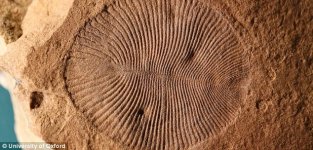Right Divider
Body part
Gee... maybe it's not 49 million years old: https://www.livescience.com/attenborough-beauty-beetle-fossil.html
Millions of yearsYou'd think it was flattened somehow...
@Stripe You word it better than I do... What's needed for fossilization?
Three physical items: Sediment, cement, water.What's needed for fossilization?
Also, in the grand scheme of things 49 million years is not that long ago. And if it happened yesterday, why aren't there *identical* beetles alive today?
Show me the identical beetles when this one was given its own name.
- There is no such thing as "49 million years ago".
- Yes, there are the identical beetles after all of that supposedly long time.
By identical, I really meant close enough. It's funny when evolutionists are so surprised when some creatures remain the same for "100's of millions of years".Show me the identical beetles when this one was given its own name.
Saying that there is doesn't make it true.Stating "there's no such thing as" doesn't make it true.
"Close enough", what according to you? What's funny is that creationists seem to think that a couple exceptionally preserved fossils = evolution is wrong.By identical, I really meant close enough. It's funny when evolutionists are so surprised when some creatures remain the same for "100's of millions of years".
Saying that there is doesn't make it true.
In the context of evolutionary theory, how likely is that?... there are plenty of genera that have stayed the same for a few dozen million years.
Millions of years is a fantasy that helps you support your false evolutionary paradigm."Close enough", what according to you? What's funny is that creationists seem to think that a couple exceptionally preserved fossils = evolution is wrong.Some organisms visually change more than others. 100s of millions of years "the same" isn't really the same in the sense that a species remains the same. But there are plenty of genera that have stayed the same for a few dozen million years.
Depends, some organisms have long generation times or slow mutation rates.In the context of evolutionary theory, how likely is that?
It's reality, sorry you don't like it. Some fossils do form catastrophically but we're looking at many separate catastrophes over a long period of time, not one single one. Fossils show patterns of older ones looking less like organisms alive today while younger ones look more like organisms alive today. Some fossils show evidence of decay and scattering. Relatively few are so beautifully preserved as the beetle in the OP. Some appear to have been deposited in oceans, others by volcanic ash, still others in river systems or deserts. There's no one catastrophe that explains them all. Early geologists figured this out over a century ago. They gave up on the idea of a global flood forming all of the geology on earth because it simply doesn't work as an explanation.Millions of years is a fantasy that helps you support your false evolutionary paradigm.
Fossils are not a picture of "millions of years of evolution", they are picture of a massively catastrophic event that buried massive amounts of plant and animal life. That is how fossils form. They do not form by any slow, long, gradual process.
That's backwards thinking - you're assuming it from the data you think you're reading. On a molecular level, why would generation times or mutation rates be independent of environmental stressors?Depends, some organisms have long generation times or slow mutation rates.
Not backwards thinking. You're speaking from ignorance. For example: Ginkgoes seem to have changed very little, but they can have generation times on the order of hundreds to thousands of years. That's quite a different situation vs finches that might have at least 1 maybe two generations per year. It's also well known that some organisms have better DNA repair mechanisms than others.That's backwards thinking - you're assuming it from the data you think you're reading. On a molecular level, why would generation times or mutation rates be independent of environmental stressors?
And how likely is it that you would have a uniform environment for a few dozen million years?
Darwin's finches differentiated in a matter of several generations,
NopeIt's reality, sorry you don't like it.
Your false paradigm does not allow you to come to a more reasonable solution.Some fossils do form catastrophically but we're looking at many separate catastrophes over a long period of time, not one single one.
This is called confirmation bias.Fossils show patterns of older ones looking less like organisms alive today while younger ones look more like organisms alive today.
Of course there is. You just prefer your false paradigm.Some fossils show evidence of decay and scattering. Relatively few are so beautifully preserved as the beetle in the OP. Some appear to have been deposited in oceans, others by volcanic ash, still others in river systems or deserts. There's no one catastrophe that explains them all.
You are a true believer.Early geologists figured this out over a century ago. They gave up on the idea of a global flood forming all of the geology on earth because it simply doesn't work as an explanation.
Hmm no. You can line up the fossils based on age/depth of burial and different organisms appear and disappear in a particular pattern.This is called confirmation bias.



Hydroplate "theory" is almost as ridiculous as flat earth-ism.You are a true believer.
The hydroplate theory is real science.
There are marine fossils at the tops of every major mountain range.And strangely you don't find Fish fossilized alongside Dickinsonia above.
That is a silly opinion. Please "pick it apart" for us. Use actual facts.Hydroplate "theory" is almost as ridiculous as flat earth-ism.
It's already been done:Please "pick it apart" for us. Use actual facts.
